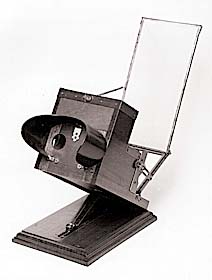
146. Ives's 'Kromskop' Stereographic Photochromoscope, c. 1895
Signed on plaque inside front: 'THE "KROMSKOP" / IVES'S PATENT / The Photochromoscope L'd / HOLBEIN HOUSE / 121 Shaftesbury Av'e LONDON W.C.', and initialled by the inventor 'F. E. I.'.
Viewer for stereoscopic colour-separation transparencies. The separations (see Item 100) are laid on the stepped part of the viewer over glass filters coloured (from the top) red, blue and green. Strongly lit from above by the hinged mirror reflector at the rear, the three images are superimposed and redirected to the viewing lenses by internal reflectors. After manual adjustment to achieve correct register, the photograph can be viewed in true colours in three dimensions.
Developed during the years 1890-95 by the American inventor Frederick Eugene Ives, the photochromoscope system was the first commercially available process of colour photography, employing the additive principle demonstrated by Clerk Maxwell in 1861. Ives's invented a number of practical colour processes but his photochromoscope gave the public its first experience of real colour photography, and stimulated the quest for more easily used processes. The photochromoscope was superseded by these after about 1900. In London, the Kromscop company, the Photochromoscope Syndicate, appointed W. Watson and Sons as their agent with the London Stereoscopic Company having the franchise for the West End.
Length 232 mm, width 165 mm, height 177 mm (untilted).
Inventory no. 81,803.